

"I loved teaching, and I knew many people in my medical school were pathologists. I had never considered it before, but I completed a pathology elective at my local community hospital, and I loved it."
Adam Berry, DO, was born and raised in Utah, just north of Salt Lake City. He completed his undergraduate studies at Utah State University in Logan, Utah, and then attended medical school at Rocky Vista University’s Southern Utah campus. He married Brianna while an undergraduate, and their first daughter, Evelyn, was born just before he started medical school. Lucy was born during his second year of medical school, so he is a girl-dad to a 5-year-old and a 3-year-old.
What motivated you to pursue a medical career?
My first couple of years in my undergraduate program, I was a bioengineering student. I had planned a career in prosthetics. I was working alone in a laboratory focusing on the tensile strengths of biomaterials. It was a Friday night, and I was by myself. I thought to myself, “I don’t want a career where I am going to be in a lab by myself all the time.” I decided to attend medical school, at which point I realized that I actually enjoy working in a lab by myself all the time, so I decided to pursue a career in pathology. That’s just a funny, full-circle story for me. More seriously, I feel that when you are in a position where you have been blessed with the opportunity to receive an education and the security to pursue academic opportunities, it is a privilege. When you have the gifts to be successful in those areas, you have a duty to provide services to people and to help people. Medicine is an avenue for all of us to do that. I can utilize my skills to provide meaningful support to humanity in my community.
 How did you decide on Pathology?
How did you decide on Pathology?
I was planning to be a urologist for the first few years of medical school. During my core surgical clerkship, I enjoyed everything about being a urologist – the patient population, the pathologies, and the procedures – but there were some aspects, as a young father, that were tough for me. The variable schedule every day, and the constant emotional attachment that was hard to step away from, made me realize that surgery probably was not something I could do long-term. I loved teaching, and I knew many people in my medical school were pathologists. I had never considered it before, but I completed a pathology elective at my local community hospital, and I loved it. It was a general surgical and heme rotation, just a lot of “bread and butter” cases.
You ranked Michigan highly for the Match. What attracted you to our program?
I attended a small, private Osteopathic school, and those institutions are not typically known for producing academic physicians. However, throughout my time in medical school, I became heavily involved in teaching and academic leadership, particularly in the osteopathic field. I decided I wanted my career to be heavily academically focused. I participated in a couple of audition rotations at some large academic institutions, and I loved the workflow, camaraderie, and mission of academic hospitals. I fell in love with genitourinary pathology, so I wanted to pursue a fellowship in genitourinary pathology. I also wanted to find a place where I could afford to live with my family. I knew Drs. Kamran Mirza and Meredith Herman from Match2Path.com, and I got to know some others here. We had a great experience on our interview day and loved the second look day. We were extremely happy to end up here. This was definitely a dream for us; so very exciting!
Tell us about your time as a resident so far. Is there anything you would like to highlight?
So far, I have had two rotations: Core Clinical Laboratory and Immunology and Special Chemistry. Residency has been great! You never know quite what to expect. You hear horror stories about it in medical school, but I have been just blown away by how kind everybody is, how ready they have been to teach me, and most impactfully, everyone defaults to respect. You don’t have to earn anyone’s respect; you have it. It has been fantastic; I have no complaints.
 What brings you the most joy in your work?
What brings you the most joy in your work?
I think what I have loved the most so far is when everybody comes together and works as a team to figure out a difficult case. We combine our expertise to find the answer as a team. I love it when we can’t do it alone; we can do it together. That is a great feeling.
Are there any mentors you would like to mention? If so, how did they impact your life?
I have had some mentors in medical school who have made a lasting impact on me. They took my name places, wrote strong letters of recommendation, and talked to people on my behalf. It is so meaningful when someone invests in you in this manner.
What is your strategy for finding balance between training and your other interests?
Buckets! You have to make buckets for different things. By that I mean spatial and time constraints. I allow myself a certain amount of time to complete my work. If I don’t finish it, it’s too bad. I’m finishing it tomorrow because I have other things and responsibilities. I find that imposing strict constraints on my time makes me more efficient and effective, allowing me to accomplish tasks more quickly. You have to set boundaries because work never ends, and it will expand to fill whatever time you give it.
What advice would you give medical students considering a career in pathology?
Regardless of which field of medicine they are interested in, I would tell them to find a career that they are passionate about. Find what you love to do and go out and do that. Work may not always be your favorite thing, but chart your path based on your passions.
What are some fun facts about you that we could share?
I can juggle any three things that are about the same size and weight, but I won’t do sharp items or fire. I also like to paint miniatures - small figurines. I also speak French. For being the language of love, it is a surprisingly ugly language. I also enjoy going for walks with my family. Moving here from the deserts of southern Utah and Nevada, the critters here are much better than the critters there. We used to see a lot of lizards, tarantulas, and scorpions. Here we see bunnies, deer, and squirrels, and lots of cool birds. We saw some cardinals by our house, which is very exciting. We don’t have cardinals in Utah. We also saw a Great Blue Heron, a lot of turkey vultures, and wild turkeys. Oh…and my favorite color is purple. That must be why I am drawn to pathology – there is a lot of purple in pathology.
Please join us in welcoming Dr. Adam Berry to our residency team! Please introduce yourself when you see him around the department.
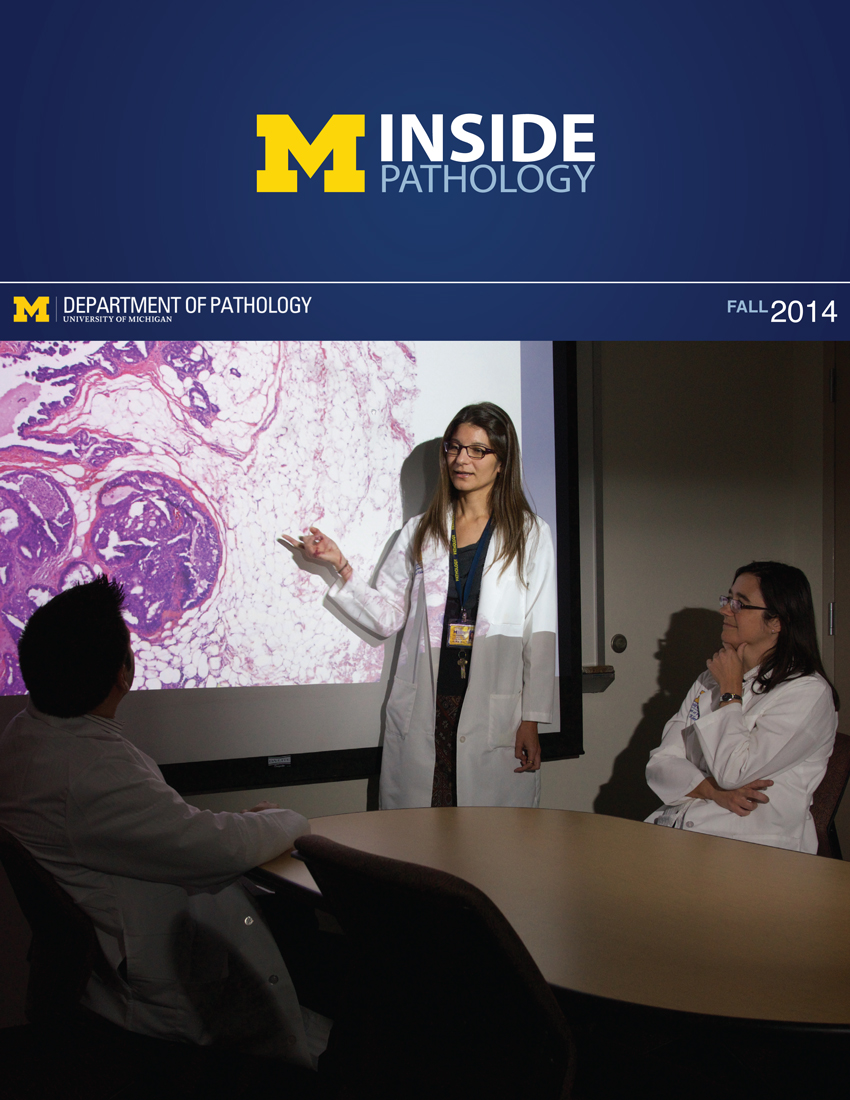 ON THE COVER
ON THE COVER
Breast team reviewing a patient's slide. (From left to right) Ghassan Allo, Fellow; Laura Walters, Clinical Lecturer; Celina Kleer, Professor. See Article 2014Department Chair |

newsletter
INSIDE PATHOLOGYAbout Our NewsletterInside Pathology is an newsletter published by the Chairman's Office to bring news and updates from inside the department's research and to become familiar with those leading it. It is our hope that those who read it will enjoy hearing about those new and familiar, and perhaps help in furthering our research. CONTENTS
|
 ON THE COVER
ON THE COVER
Autopsy Technician draws blood while working in the Wayne County morgue. See Article 2016Department Chair |

newsletter
INSIDE PATHOLOGYAbout Our NewsletterInside Pathology is an newsletter published by the Chairman's Office to bring news and updates from inside the department's research and to become familiar with those leading it. It is our hope that those who read it will enjoy hearing about those new and familiar, and perhaps help in furthering our research. CONTENTS
|
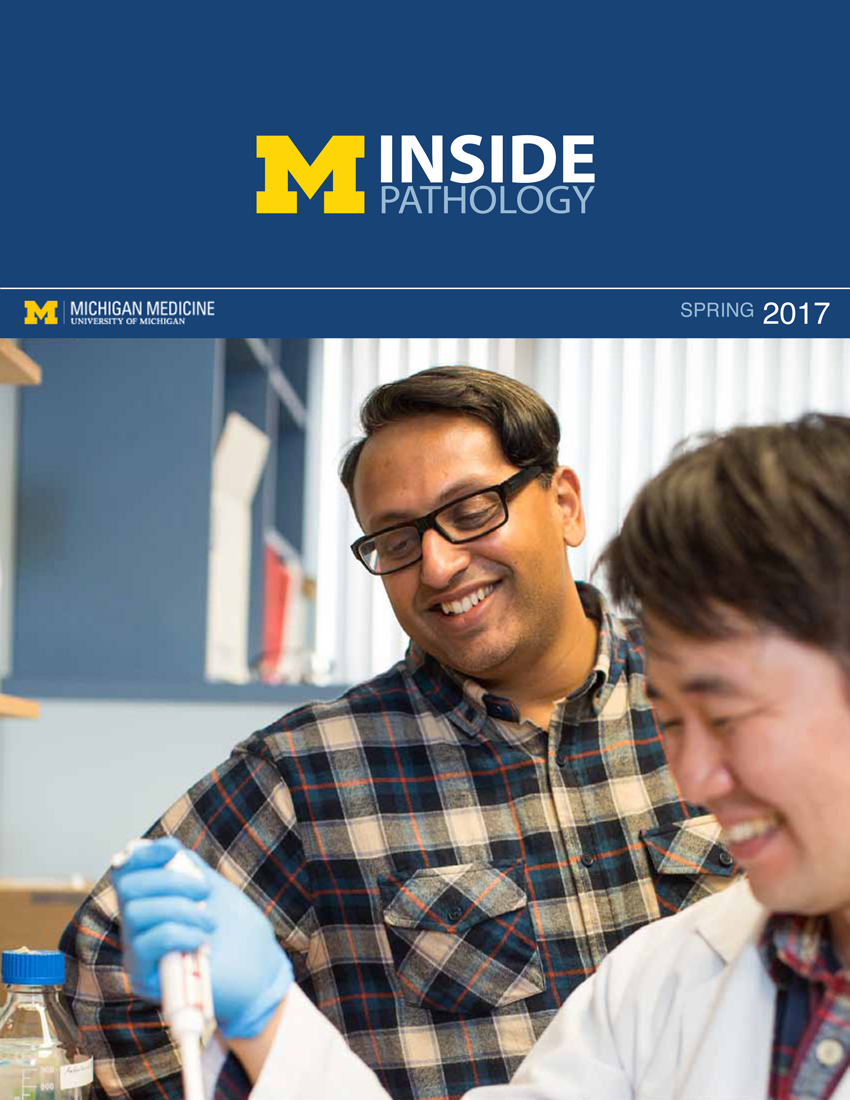 ON THE COVER
ON THE COVER
Dr. Sriram Venneti, MD, PhD and Postdoctoral Fellow, Chan Chung, PhD investigate pediatric brain cancer. See Article 2017Department Chair |

newsletter
INSIDE PATHOLOGYAbout Our NewsletterInside Pathology is an newsletter published by the Chairman's Office to bring news and updates from inside the department's research and to become familiar with those leading it. It is our hope that those who read it will enjoy hearing about those new and familiar, and perhaps help in furthering our research. CONTENTS
|
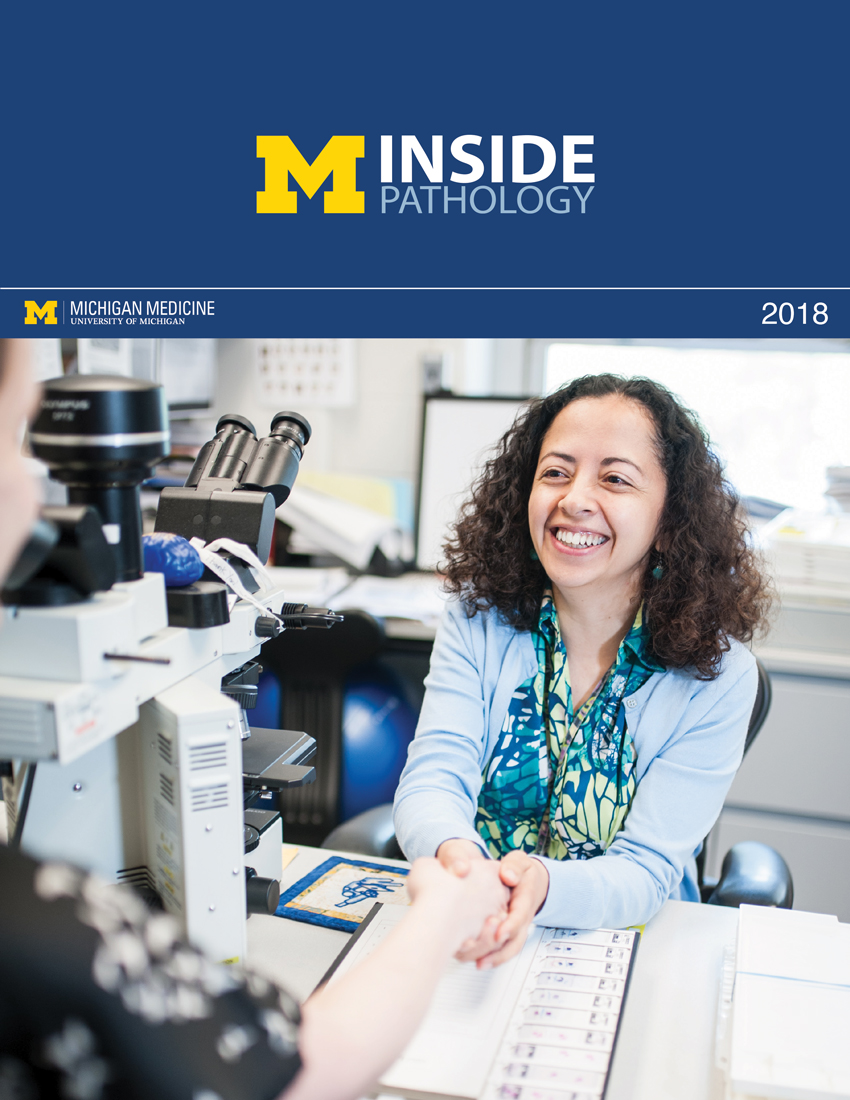 ON THE COVER
ON THE COVER
Director of the Neuropathology Fellowship, Dr. Sandra Camelo-Piragua serves on the Patient and Family Advisory Council. 2018Department Chair |

newsletter
INSIDE PATHOLOGYAbout Our NewsletterInside Pathology is an newsletter published by the Chairman's Office to bring news and updates from inside the department's research and to become familiar with those leading it. It is our hope that those who read it will enjoy hearing about those new and familiar, and perhaps help in furthering our research. CONTENTS
|
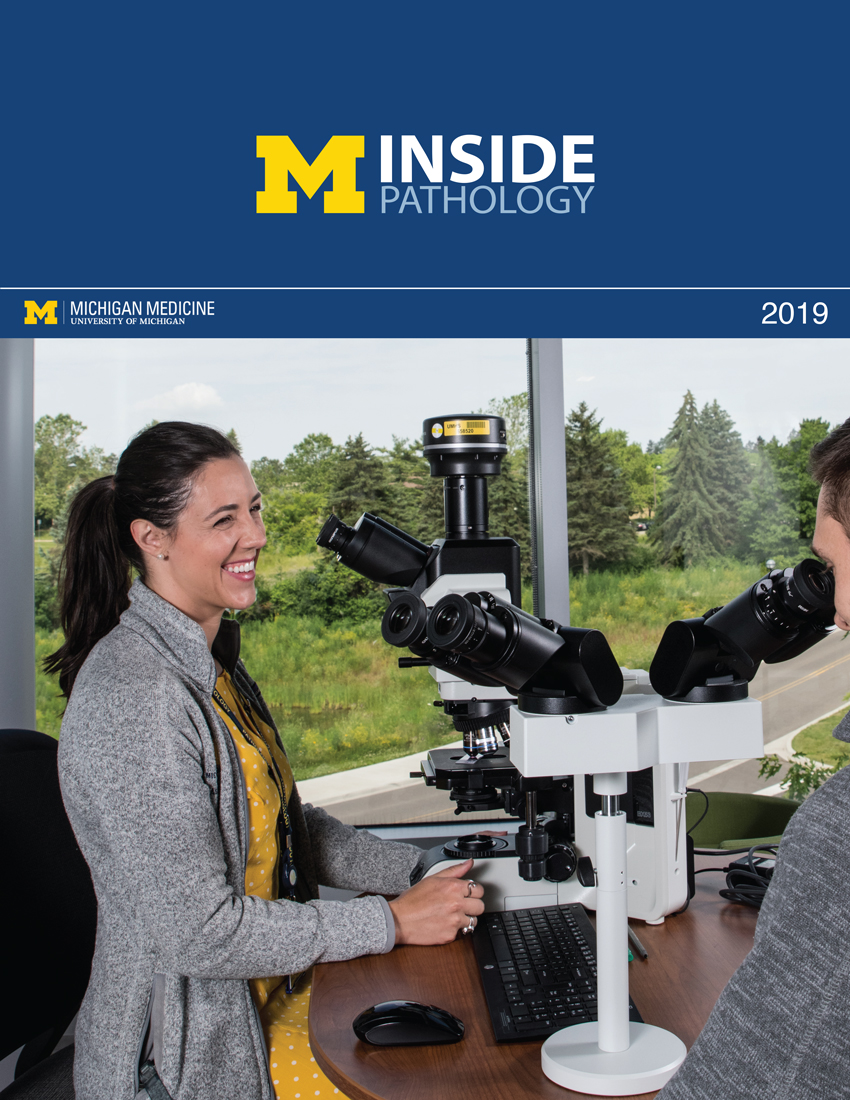 ON THE COVER
ON THE COVER
Residents Ashley Bradt (left) and William Perry work at a multi-headed scope in our new facility. 2019Department Chair |

newsletter
INSIDE PATHOLOGYAbout Our NewsletterInside Pathology is an newsletter published by the Chairman's Office to bring news and updates from inside the department's research and to become familiar with those leading it. It is our hope that those who read it will enjoy hearing about those new and familiar, and perhaps help in furthering our research. CONTENTS
|
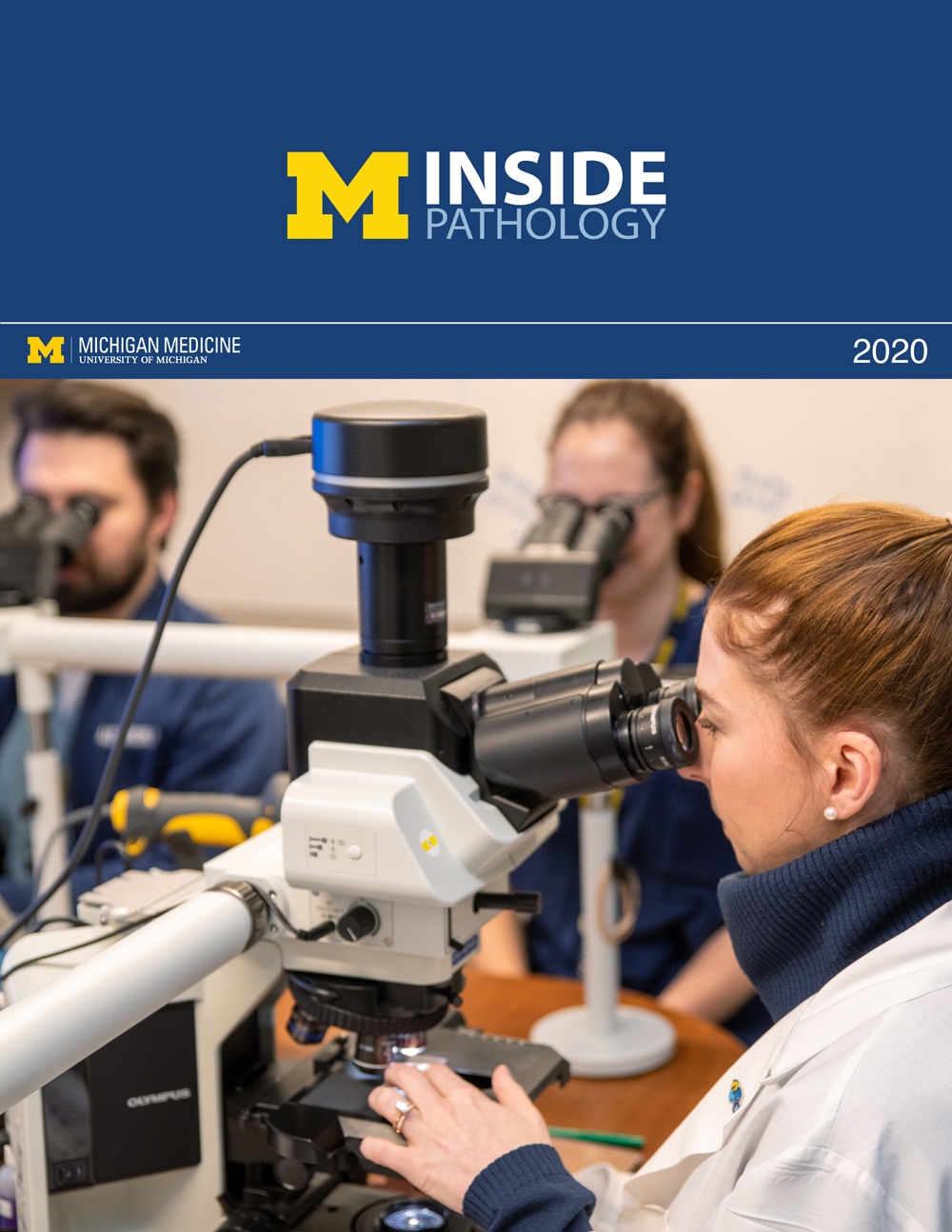 ON THE COVER
ON THE COVER
Dr. Kristine Konopka (right) instructing residents while using a multi-headed microscope. 2020Department Chair |

newsletter
INSIDE PATHOLOGYAbout Our NewsletterInside Pathology is an newsletter published by the Chairman's Office to bring news and updates from inside the department's research and to become familiar with those leading it. It is our hope that those who read it will enjoy hearing about those new and familiar, and perhaps help in furthering our research. CONTENTS
|
 ON THE COVER
ON THE COVER
Patient specimens poised for COVID-19 PCR testing. 2021Department Chair |

newsletter
INSIDE PATHOLOGYAbout Our NewsletterInside Pathology is an newsletter published by the Chairman's Office to bring news and updates from inside the department's research and to become familiar with those leading it. It is our hope that those who read it will enjoy hearing about those new and familiar, and perhaps help in furthering our research. CONTENTS
|
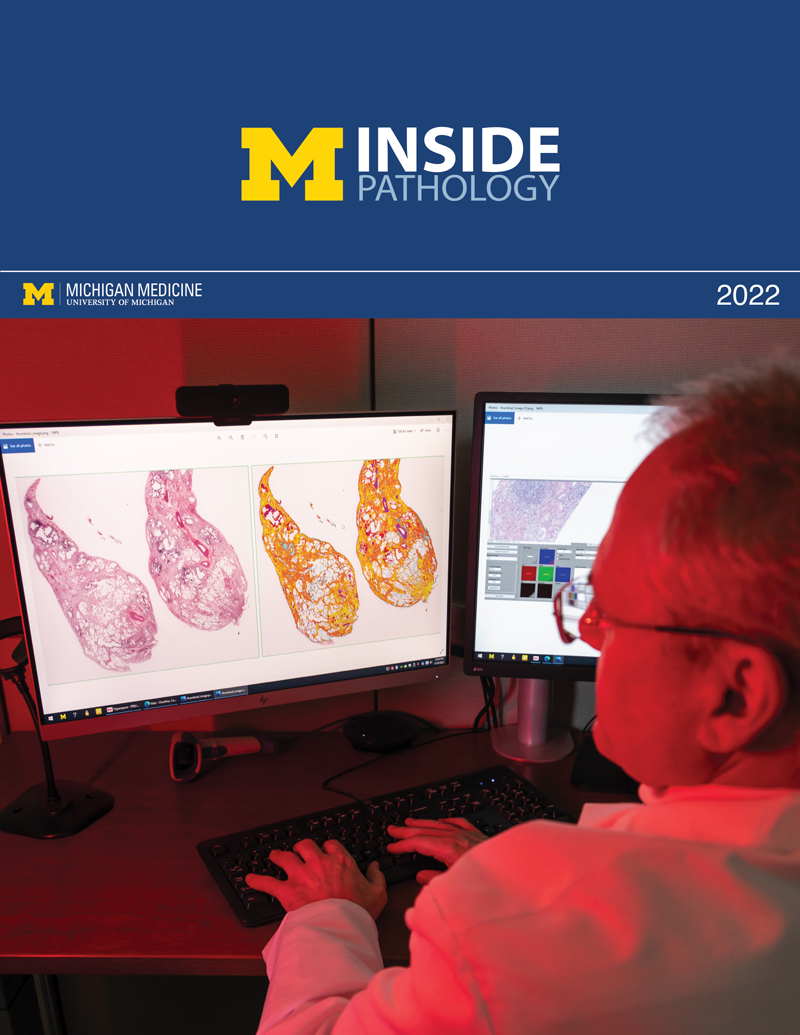 ON THE COVER
ON THE COVER
Dr. Pantanowitz demonstrates using machine learning in analyzing slides. 2022Department Chair |

newsletter
INSIDE PATHOLOGYAbout Our NewsletterInside Pathology is an newsletter published by the Chairman's Office to bring news and updates from inside the department's research and to become familiar with those leading it. It is our hope that those who read it will enjoy hearing about those new and familiar, and perhaps help in furthering our research. CONTENTS
|
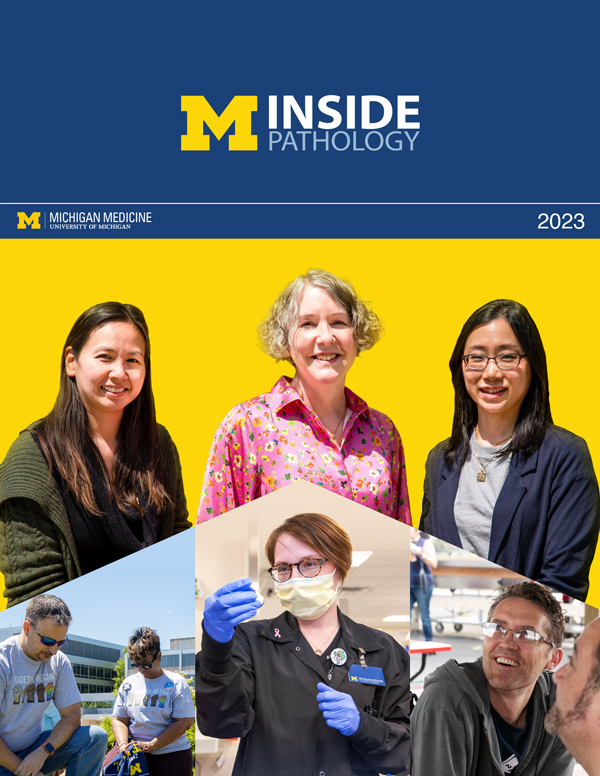 ON THE COVER
ON THE COVER
(Left to Right) Drs. Angela Wu, Laura Lamps, and Maria Westerhoff. 2023Department Chair |

newsletter
INSIDE PATHOLOGYAbout Our NewsletterInside Pathology is an newsletter published by the Chairman's Office to bring news and updates from inside the department's research and to become familiar with those leading it. It is our hope that those who read it will enjoy hearing about those new and familiar, and perhaps help in furthering our research. CONTENTS
|
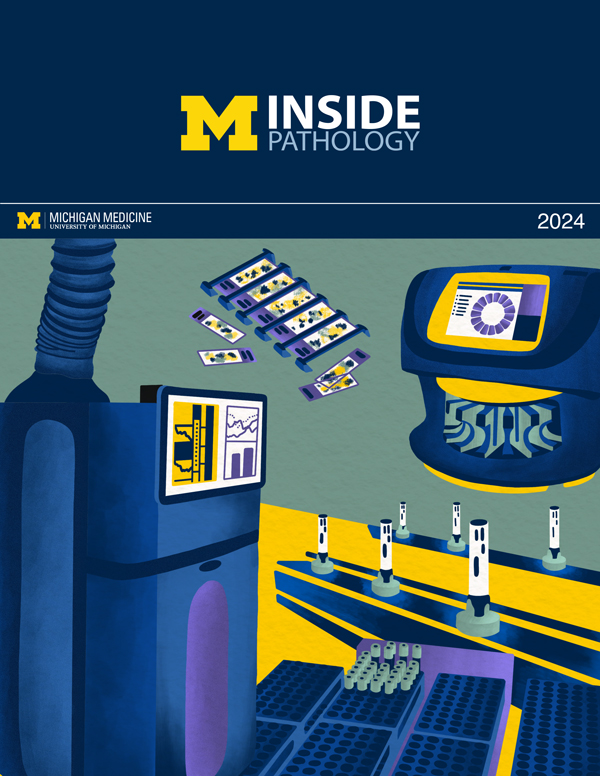 ON THE COVER
ON THE COVER
Illustration representing the various machines and processing used within our labs. 2024Department Chair |

newsletter
INSIDE PATHOLOGYAbout Our NewsletterInside Pathology is an newsletter published by the Chairman's Office to bring news and updates from inside the department's research and to become familiar with those leading it. It is our hope that those who read it will enjoy hearing about those new and familiar, and perhaps help in furthering our research. CONTENTS
|
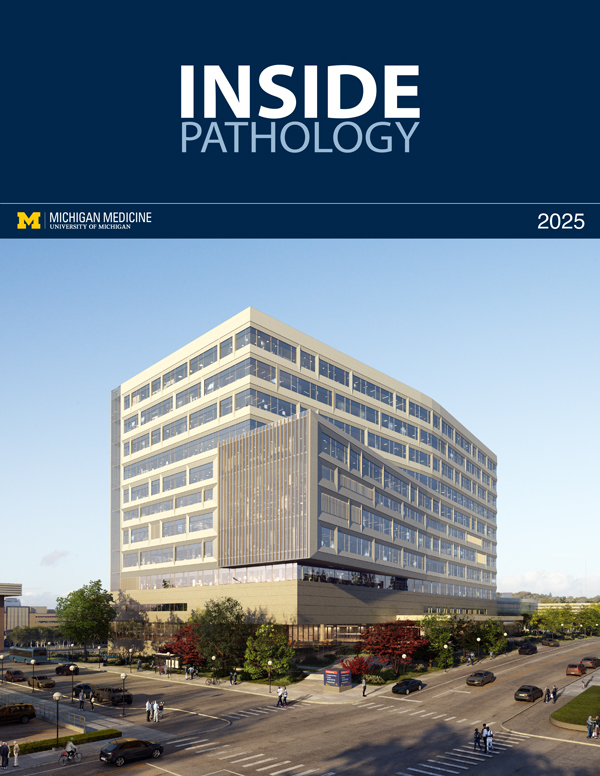 ON THE COVER
ON THE COVER
Rendering of the D. Dan and Betty Khn Health Care Pavilion. Credit: HOK 2025Department Chair |

newsletter
INSIDE PATHOLOGYAbout Our NewsletterInside Pathology is an newsletter published by the Chairman's Office to bring news and updates from inside the department's research and to become familiar with those leading it. It is our hope that those who read it will enjoy hearing about those new and familiar, and perhaps help in furthering our research. CONTENTS
|

MLabs, established in 1985, functions as a portal to provide pathologists, hospitals. and other reference laboratories access to the faculty, staff and laboratories of the University of Michigan Health System’s Department of Pathology. MLabs is a recognized leader for advanced molecular diagnostic testing, helpful consultants and exceptional customer service.